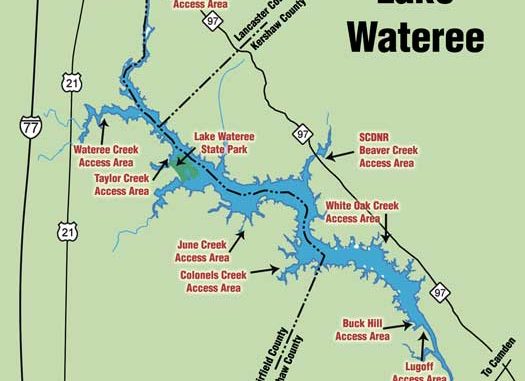
Up-to-date tactics will help you fill your cooler this month with Lake Wateree crappie.
Years ago, crappie fishing was a pretty laid-back, contemplative fishing experience.
Using three or four land markers — a large tree, a dock, a point — you located a position where you had caught crappie before and anchored there. Then, you set out cane poles baited with minnows, sat back and contemplated world affairs while waiting on the fish to bite.
Today, crappie fishing is a vastly different sport. Using signals from satellites circling high above the earth, you guide your boat above underwater structure known to hold crappie, your trolling motor moving your boat at a very slow speed. The cane poles have been replaced by super-sensitive graphite rods, and the minnows often are hooked to a variety of small multi-colored jigs.
With a dozen, perhaps nearly twice that many rods to watch, there is no time to contemplate anything but where the next bite will come.
So Marc Danque guided the boat down the edge of the river channel, marking sunken brushpiles and other structure on his depthfinder, which often lit up with signals from fish under the boat. A rod tip dipped suddenly, and he lifted a nice Wateree slab into the boat.
The morning had dawned cold and foggy, like many early spring mornings. The movement of the boat carried a bitter chill until well after the fog had lifted. In early spring, it is always a good idea to dress in layers. You can always peel off a jacket or a sweatshirt when the sun gets overhead and begins to warm things up.
“In early March, the fish are usually starting to move,” Danque said. “They are getting ready to go into the creeks to spawn, and you can catch them out in front of those creeks. June Creek, Wateree Creek and Rochelle Creek are excellent areas to fish this time of year. Generally, from Beaver Creek up is where most of the fish are caught that time of year.”
At this point, the fish are not very deep; Danque said they’re usually holding around eight to 12 feet deep. And they are fat, feeding heavily for the spawn and beginning to fill with roe.
“By late March, fish will be moving into the creeks, getting a little shallower and getting a little bit more aggressive. They are ready to go for the spawn — as soon as the full moon hits and the water temperature is just right, about 55 to 60 degrees.”
Mark your calendar. The full moons this spring are March 21 and April 20. Some crappie will spawn in March, but the majority will spawn in April, Danque said.
“The females will run in and spawn for a day or so, and then they will come back out and the bucks will move in. It doesn’t take long for them to spawn.”
Catching females is fairly easy in prespawn and during the spawn, but once they spawn, they move back to deeper water and go into a dormant phase, Danque said, feeding only enough to maintain the level of nourishment needed to stay healthy. But the males are a different story.
“The males are very aggressive (at) this time. You can catch them trolling, tight-lining, and jigging docks — about any way you want to catch them. They are just real mean at this time.”
Once the spawn is over, crappie fishing can get a little slow for a while, Danque said. The females have expended their eggs, and the males have used up their energy guarding them.
“They are just tired and don’t want to do much,” he said. “They are not very aggressive. They might just run up to the bait, and you’ll see the rod tip just roll back when trolling, but they might turn it loose. They are not interested in chasing bait. They will take the opportunity to get a meal, but if it’s too much trouble, they will just let it pass on by.”
That said, he noted, even in late spring Wateree is a very good lake for crappie.
“Wateree is probably the best lake in South Carolina as far is fishing for crappie year- round. It’s also a lake where you can catch them tight-lining or trolling any time of the year. In March, you don’t have an advantage using one tactic or the other. It’s whatever you like to do best.”
Those are strong words from a crappie fisherman who actually lives on Lake Murray. Danque’s life and his livelihood revolve around crappie fishing.
He is one of the fishermen to beat in crappie tournaments all over the Southeast, and he is a tournament organizer. He also runs a retail shop dedicated to crappie fishing: The Crappie Hole, behind his home on Stoney Point Lane near Chapin. It has everything an angler could possibly need to catch crappie. All of the tackle manufacturers are represented in The Crappie Hole, every kind, color and size of crappie jig, from hair bodies to plastic tails and tube attachments that imitate the small minnows the fish feed on. He also runs a factory repair shop for Motor Guide trolling motors, which provide boats with the slow propulsion necessary to move the baits at the right speed.
For Danque, there is a time for trolling and a time for tight-lining for crappie, a decision he makes based on 20 years of fishing exclusively for the fish.
“I like trolling, and I can catch more fish trolling, but I can’t always catch the bigger fish,” he said. “A lot of times, I will go to a lake and troll the first day just to locate the fish — because you can cover so much more area by trolling. Then I may go back to the areas where I caught fish and tight-line through there to see if a slower presentation will get a bigger bite.”
Sometimes other factors will enter the decision making process.
“If there are a lot of leaves and pine straw on the water, it’s too much trouble to troll. You have to deal with the situation Mother Nature hands you, and usually with rising water, you are going to see more trash on the water.”
Rising water can be a major factor at Lake Wateree with frequent spring rains, which can change the lake level quickly and also wash leaves, limbs and other debris into the water. The influx can also create long stretches of muddy water, which can have a major effect on crappie fishing.
“Generally the water in the upper half of the lake has some color to it all the time,” Danque said. “The lower half of the lake tends to clear up unless we have a lot of rain, and then it can get muddy from one end to the other.”
Beaver Creek, about midway down the lake, is usually the breakpoint, Danque said, with the water down the lake normally clearer than the water up the lake. While he prefers to fish dingy water, fishing can be tough in really muddy water. The knowledgeable crappie fisherman can even use that to his advantage, he said.
“Fish are not as easily spooked in dingy water as they are in clear water,” Danque said. “After I learned how to catch them in dingy water, even in blood-red water, I found it a whole lot easier to catch them than in crystal-clear water. Now, I hunt the dingy water and use different colored baits,” he said. “Generally, the fish will be a little bit shallower, coming up into the muddier area because they feel safer. They can come up and sun a little bit, but in clearer water, the sun penetrates deeper and the fish stay deeper.”
Crappie tend to seek cover and associate closer to structure in the clearer water, he said. But in dingy water, they will stay scattered out more and be hunting prey because they think they are hidden.
“Now, if we get a lot of fresh, muddy water, I tend to stay away from that,” he said. “The fish will pull out of the really muddy water, so I will fish around the mud line. For instance, when Wateree gets a lot of rain, you can go to the mouth of Wateree Creek and see a distinct mud line. If it’s really muddy and trashy, just go to the edges of the creeks where the water is passing by, and the fish will move right out of the river into the clearer water and stay there until the lake stabilizes in a couple of days.”
Another thing to remember, he said, is that when the water is rising — as with spring rains — crappie will tend to move to shallower areas. At Wateree, they will get up on the flats when the water is rising and hold in eight or nine or 10 feet, out of the current, behind points.
Water clarity influences the choice of color for jigs, Danque said. The rule of thumb is to fish darker-colored jigs, such as black or orange, in dingy water to create more of a silhouette. For clearer water, Danque recommends light blue and white/pink. Black/chartreuse and purple/chartreuse are basic colors for Lake Wateree, he said, and orange/chartreuse is particularly good for the upper part of the lake.
“Put a different color or color combination on each pole until you find out what they want that day. If you catch one on a blue/white combination, you wonder if they are after blue or white. So try a blue/black and some other color with some white in it and keep changing until you key in on what they want. And remember, they will change during the day, too, so if you quit catching fish, change colors.”
The type of jig can make a difference, too, Danque said. For instance, in the colder water of early spring, he uses a jig without much action — a hair jig, tube jig or slider. But as spring warms up, the fish tend to like more action, he said, so he goes more with jigs like the Triple Ripple, Kalin, AWD Sire Baits — anything with a curly tail. He almost always tips the jigs with a live minnow and, he noted, sometimes the best bait is simply a live minnow on a Carolina rig.
Whether on a plain hook or on a jig, the minnow is hooked from the bottom lip through the top for both trolling and tight lining. With a jig, — the idea is for the crappie to think the minnow is chasing the jig, so he can get two dinners with one gulp or at least get the minnow chasing the jig. The key is the presentation to the fish, Danque said.
“I like to fish with the current, because the fish stage up facing into the current. That way, you have a longer presentation time for your bait. If you are going against the current, you will bring the bait up over their backs where they don’t have a chance to see it for a very long period.”
By mid-morning, the sun had finally burned away the fog and was beginning to warm our surroundings. The fishing had picked up, and a number of nice crappie and some white perch were cooling in the fish box. But by early afternoon, the bite slowed, and it was time to head in. Although it started off bone-chilling cold, it had been another good day of crappie fishing on Lake Wateree.
While Lake Wateree is one of his favorite places to fish for crappie, whether spring or fall, most any weekend, Danque is likely to be on a reservoir somewhere in the Southeast competing in a tournament. One day of crappie fishing two decades ago hooked him on chasing slabs for life.
“Back in 1988, a friend talked me into entering a crappie tournament on Lake Murray, and I won it. I thought I was good, but it was four years later and many thousands of dollars spent traveling all over the country before I did anything else in a tournament besides being a participant,” he said.
“Before that, I generally just fished for what was in season, whether chasing stripers or schooling black bass. We used to only fish for crappie in March and April. Now it’s year round. Now I don’t fish for anything but crappie.”


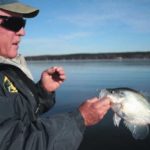
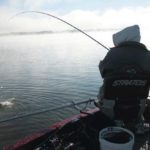
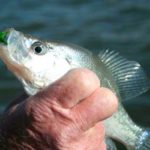
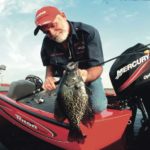
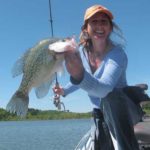
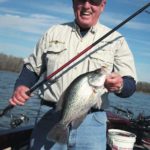
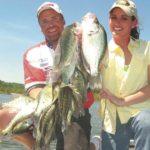


Be the first to comment